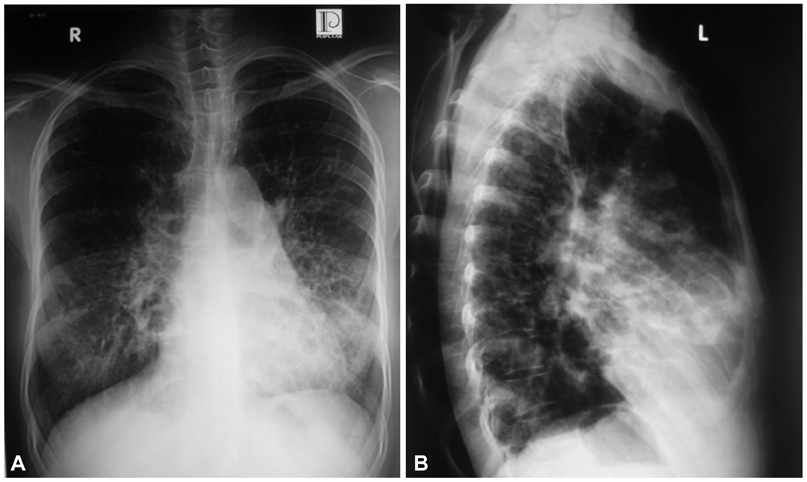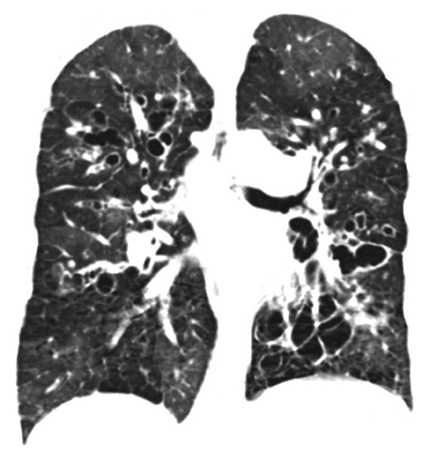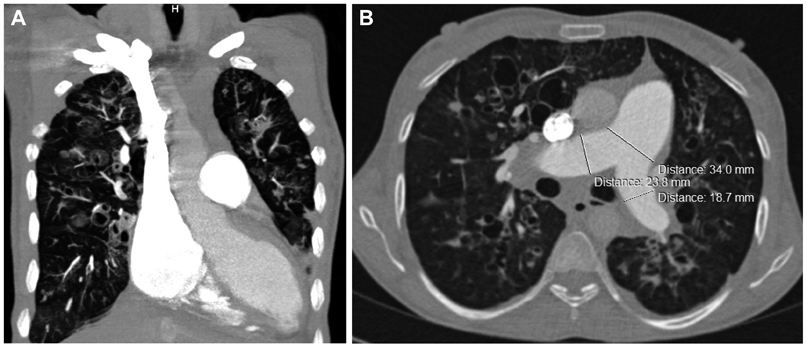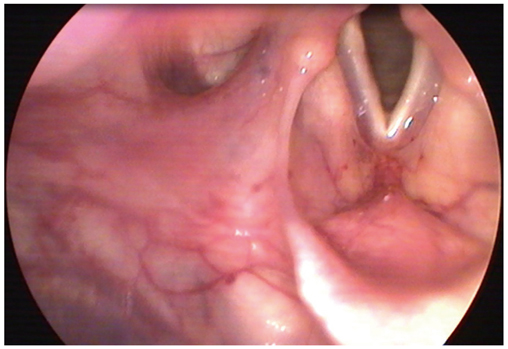Korean Circ J.
2012 Jul;42(7):507-510. 10.4070/kcj.2012.42.7.507.
Ortner Syndrome due to Concomitant Mitral Stenosis and Bronchiectasis
- Affiliations
-
- 1Department of Cardiology, National Institute of Cardiovascular Diseases, Dhaka, Bangladesh. drmonwarbd@yahoo.com
- KMID: 2094126
- DOI: http://doi.org/10.4070/kcj.2012.42.7.507
Abstract
- Ortner syndrome or cardiovocal syndrome is a rare condition characterized by hoarseness of voice associated with cardiovascular pathology. Compression of the left recurrent laryngeal nerve by the pulmonary artery or left atrium is usually responsible. Recurrent aspiration pneumonia may cause significant morbidity and mortality. Early recognition and treatment along with removal of the underlying cause, if possible, may change an otherwise poor prognosis of the condition. The case presented here describes a 35-year old female with hoarseness of voice in association with mitral stenosis and bronchiectasis. Presence of dual pathology contributed to the overall pathophysiology of the disease, and made its management difficult.
MeSH Terms
Figure
Reference
-
1. Ortner N. Recurrent laryngeal nerve paralysis due to mitral valve stenosis. Wien Klin Wochenschr. 1897. 10:753–755.2. Plastiras SC, Pamboucas C, Zafiriou T, Lazaris N, Toumanidis S. Ortner's syndrome: a multifactorial cardiovocal syndrome. Clin Cardiol. 2010. 33:E99–E100.3. Prada-Delgado O, Barge-Caballero E. Images in clinical medicine: Ortner's syndrome. N Engl J Med. 2011. 365:939.4. Gulel O, Koprulu D, Kucuksu Z, Yazici M, Cengel S. Images in cardiovascular medicine: cardiovocal syndrome associated with huge left atrium. Circulation. 2007. 115:e318–e319.5. Rubens F, Goldstein W, Hickey N, Dennie C, Keon W. Hoarseness secondary to left atrial myxoma. Chest. 1989. 95:1139–1140.6. Kagal AE, Shenoy PN, Nair KG. Ortner's syndrome associated with primary pulmonary hypertension. J Postgrad Med. 1975. 21:91–95.7. Nakao M, Sawayama T, Samukawa M, et al. Left recurrent laryngeal nerve palsy associated with primary pulmonary hypertension and patent ductus arteriosus. J Am Coll Cardiol. 1985. 5:788–792.8. Ishimoto S, Ito K, Toyama M, et al. Vocal cord paralysis after surgery for thoracic aortic aneurysm. Chest. 2002. 121:1911–1915.9. Escribano JF, Carnés J, Crespo MA, Antón RF. Ortner's syndrome and endoluminal treatment of a thoracic aortic aneurysm: a case report. Vasc Endovascular Surg. 2006. 40:75–78.10. Lee SI, Pyun SB, Jang DH. Dysphagia and hoarseness associated with painless aortic dissection: a rare case of cardiovocal syndrome. Dysphagia. 2006. 21:129–132.11. Albertini RE. Vocal cord paralysis associated with pulmonary emboli. Chest. 1972. 62:508–510.12. Victoria L, Graham SM, Karnell MP, Hoffman HT. Vocal fold paralysis secondary to cardiac countershock (cardioversion). J Voice. 1999. 13:414–416.13. Pai RK, Boyle NG, Child JS, Shivkumar K. Transient left recurrent laryngeal nerve palsy following catheter ablation of atrial fibrillation. Heart Rhythm. 2005. 2:182–184.14. Tewari P, Aggarwal SK. Combined left-sided recurrent laryngeal and phrenic nerve palsy after coronary artery operation. Ann Thorac Surg. 1996. 61:1721–1722.15. Murty GE, Smith MC. Recurrent laryngeal nerve palsy following heart-lung transplantation: three cases of vocal cord augmentation in the acute phase. J Laryngol Otol. 1989. 103:968–969.16. Solanki SV, Yajnik VH. Ortner's syndrome. Indian Heart J. 1972. 24:43–46.17. Meyer E, Jonas NE, Zühlke LJ. Ortner syndrome. S Afr J Child Health. 2008. 2:170–171.18. Ishii K, Adachi H, Tsubaki K, Ohta Y, Yamamoto M, Ino T. Evaluation of recurrent nerve paralysis due to thoracic aortic aneurysm and aneurysm repair. Laryngoscope. 2004. 114:2176–2181.19. Mulpuru SK, Vasavada BC, Punukollu GK, Patel AG. Cardiovocal syndrome: a systematic review. Heart Lung Circ. 2008. 17:1–4.20. Hartl DM, Travagli JP, Leboulleux S, Baudin E, Brasnu DF, Schlumberger M. Clinical review: current concepts in the management of unilateral recurrent laryngeal nerve paralysis after thyroid surgery. J Clin Endocrinol Metab. 2005. 90:3084–3088.
- Full Text Links
- Actions
-
Cited
- CITED
-
- Close
- Share
- Similar articles
-
- A Giant Left Atrium in Rheumatic Mitral Stenosis
- Life Threatening Hemoptysis in Mitral Stenosis Treated by Emergency Mitral Commissurotomy
- Reversible Ortner’s Syndrome as a Presenting Feature of Thyrotoxicosis in an Adolescent: A Rare Case Report
- Cineangiographic findings of mitral stenosis
- Assessment of Mitral Stenosis by Doppler Echocardiography: Influence of Regurgitation on Doppler Pressure Half-Time





